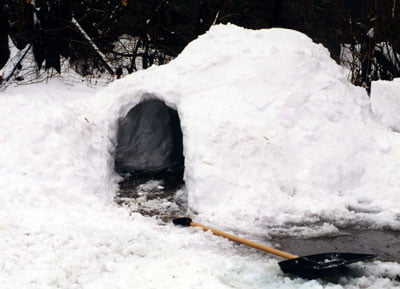The peoples of the circumpolar regions have been keeping warm with the help of snow for thousands of years. Even today, they still use snow structures for hunt camps and emergency situations. They are probably a bit more resilient than most of us but with a little know-how and little or no tools, a snow shelter can save your life. Basic tools you should always have include a shovel, a tarp, a space blanket and survival kit with long-burning candles.
Building an igloo takes skill and a lot of time for a novice and, in an emergency, is likely beyond our capabilities. However snow blocks similar to ones for an igloo can be stacked as a wind-block or straight sided walls to support a tarp or around a snow trench.
A snow trench is simple and the fastest protective structure. Just find a spot where the snow is deeper and dig a trench a bit longer than your body. Make it as wide as you need to accommodate however many people there are. Any more than two or three people might require a separate trench. The trench should be kept narrow to retain any warmth. If not alone, cuddling is strongly suggested. Make the entrance at a right angle to one of the ends to minimize cold air entry. Stretch your tarp across the opening of the trench. If the tarp is large enough,pull part of it down across the entrance. Place snow blocks or lumps around the tarp edges to hold it secure. Digging a cave out of drifted snow works well and in this case your tarp and space blankets can be used to wrap around you. Again, have the entrance at right angles to the part you will occupy. Candles will give you light and heat.
 A quinzee is simply a snow cave in a snow pile you have created. Use your shovel to make a snow pile at least two meters high and two to three meters across. After the pile is complete, it needs to be allowed to consolidate (stiffen) and this will take one or two hours. This is your time to gather firewood for an outside fire, and pine boughs or other vegetation for the interior sleeping area. After the pile has stiffened up,use the shovel to start the entrance-way and empty the interior. Twigs and sticks should be pushed into the pile to a depth of 12 inches, so when clearing the interior you can see when the roof is about 12 inches thick. Clear to the level of surrounding snow and then deeper in the centre. This keeps the sleeping areas higher than the low point which is where the cold air will gather. Spread pine boughs where you will sleep and cut and place a snow block at the door. If you are using candles or other heat source, create a vent hole at the high point of the roof to allow ventilation.
A quinzee is simply a snow cave in a snow pile you have created. Use your shovel to make a snow pile at least two meters high and two to three meters across. After the pile is complete, it needs to be allowed to consolidate (stiffen) and this will take one or two hours. This is your time to gather firewood for an outside fire, and pine boughs or other vegetation for the interior sleeping area. After the pile has stiffened up,use the shovel to start the entrance-way and empty the interior. Twigs and sticks should be pushed into the pile to a depth of 12 inches, so when clearing the interior you can see when the roof is about 12 inches thick. Clear to the level of surrounding snow and then deeper in the centre. This keeps the sleeping areas higher than the low point which is where the cold air will gather. Spread pine boughs where you will sleep and cut and place a snow block at the door. If you are using candles or other heat source, create a vent hole at the high point of the roof to allow ventilation.
It will amaze you how much warmer you are inside a snow structure compared to having no protection from the elements.




